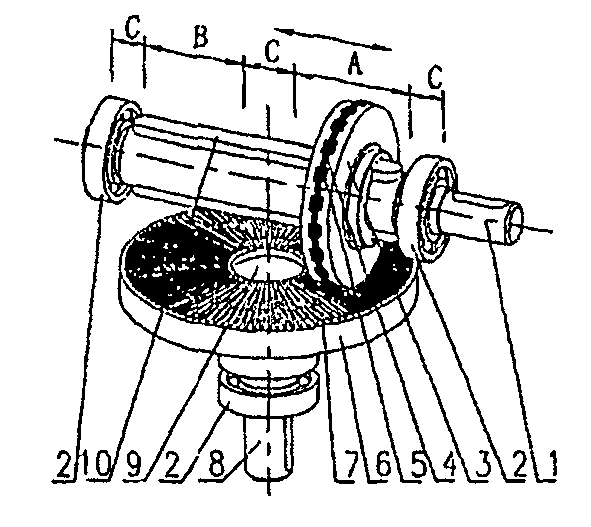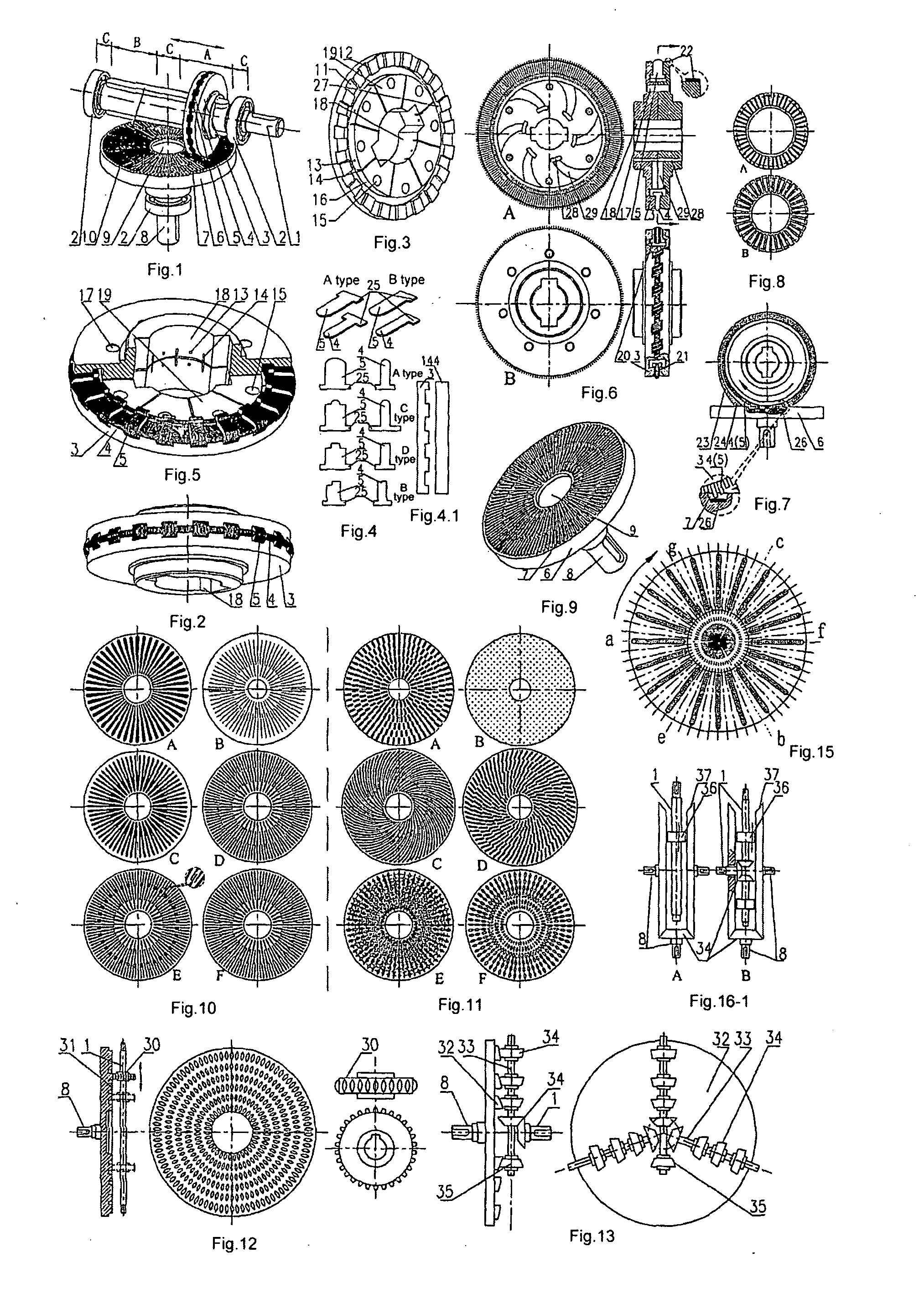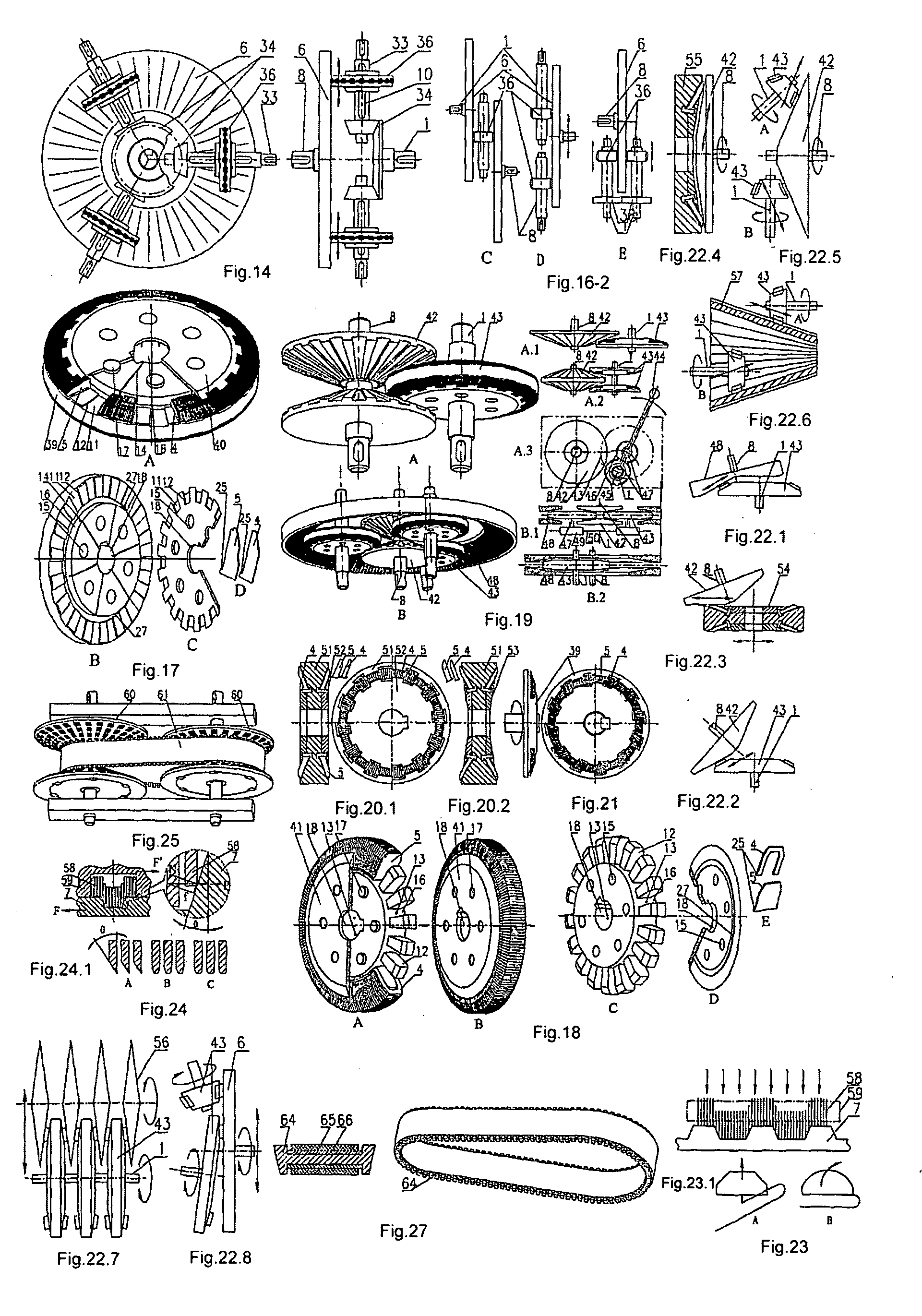[0004] With regard to this, the main object of the invention is to provide a variable-tooth gear with sliding-sheet deforming teeth, which has characteristics of large
load capacity,
high transmission efficiency, simple structure, low cost and compactness. This variable-tooth gear realizes, to the core, the concept of “
continuously variable transmission via gear meshing”, and can be widely applied to vehicles or industrial fields of high speed and large power.
[0005] A further object of the invention is to provide a variable-tooth rack with sliding-sheet deforming teeth, which has characteristics of large
load capacity,
high transmission efficiency, simple structure, low cost and compactness. This variable-tooth rack realizes in deed the concept of “
continuously variable transmission via rack meshing”, and can be widely applied to vehicles or industrial fields of high speed and large power.
[0023] a CVT with a variable-tooth cylindrical gear: the input shaft is coupled to the tooth-and-groove wheel, the variable-tooth gear is coupled to an output shaft via guiding splines or splines, the variable-tooth gear can freely move in the axial direction while transmitting torques, thereby continuously varying the meshing
radius with the tooth-and-groove wheel to perform continuously variable transmission; an
electromagnet or a permanent
magnet can be provided on the tooth-and-groove wheel disc or at a place corresponding thereto so as to induce magnetic forces onto the sliding-sheets to make them return, or a permanent
magnet or an
electromagnet can be provided inside the variable-tooth gear, all sliding-sheets are permanently magnetized or electro-magnetized so as to be moved outwards via repellent forces to implement returning; alternatively, returning can be performed via the magnetic induction interactions between the
magnetic field and the inducing current induced by the movement of sliding-sheets in the
magnetic field (or alternate
electromagnet field); alternatively, the generation device which generates the returning driving forces for sliding-sheets can be stationary and does not participate in motion, the electromagnet itself can be stationary and does not follow the tooth-and-groove disc to move, the sliding-sheets can be attracted to return by magnetic induction; (as for returning via electromagnetic forces) the design radial dimension of free centrifugal returning at the state of sliding-sheets separating from the
gear wheel can be larger than, equal to, or smaller than the returning radial dimension when meshing with the tooth-and-groove wheel; a central recess 9 can be provided at the center of the tooth-and-groove wheel; the distance between the grooves of the tooth-and-groove wheel can be or can not be a multiple of the distance between the sliding-sheet groups; a
lubricant hole (or a
lubricant slit) can be provided on the wheel body, the inside of the wheel body can also be designed as a structure of a
centrifugal pump, a friction traction ring 22 can be provided at the outer edge of the variable-tooth gear, the friction traction ring can be made of elastic materials such as rubber; an non-closed outer constraining ring for sliding-sheets 23 can be disposed on the outer circumference of the variable-tooth gear, an arc-shaped transition guiding zone 24 can be designed in the direction that faces the sliding-sheets' rotations into the constraining ring so as to improve the operation reliability, now the sliding-sheets can be dispensed with the stop legs, the sliding-sheets can also be replaced by sliding-needles; alternatively, a stress-suppressing pad layer 26 can be attached to the bottom of the concave grooves of the tooth-and-groove disc, which pad is generally made of elastic and soft
filling materials, such as
spray coating rubber materials, etc.;
[0046] the rollers of the rotary shaft roller wheel can take a conic shape, and the performance of continuously variable transmission is basically improved by using of the self-locking property; its working surface can also be made to be an arc shape; alternatively: the rotary shaft roller wheel can be replaced with a gear, a
bevel gear, a worm wheel or a worm to mesh with the sliding-sheets of the variable-tooth cylindrical gear, the variable-tooth cylindrical gear can also be replaced with a variable-tooth conic gear; alternatively: a transmission in which the rotation shaft of the rotary shaft roller wheel is fixed and the rotation shaft of the variable-tooth cylindrical gear can rotate is employed;
[0067] an infinitely meshing transmission with sliding-blocks: its infinitely meshing device unit is a “sliding-block infinitely meshing” device, the tooth profiles on the inner side of the sliding meshing triangular
toothed belt, a chain 186 whose triangular teeth at the inner side meshes through sliding, capable of meshing via sliding with the tapered tooth blocks 187 by automatically finding the meshing points through mechanical sliding, the tapered tooth blocks 187 moves in the trails 189, in x direction, they can return via centrifugal forces; in y direction, they are self-locked, in operation, the tapered tooth blocks can freely return in x direction until they reach the optimal meshing end of the triangular-tooth driving belt capable of meshing via sliding 186 so as to mesh sufficiently with the surfaces of the triangular teeth; they are self-locked in y direction, by juxtaposing and operating two types of tapered tooth blocks, denoted by a and b, which are orientated along complementary rails, it is realized thus that the infinitely meshing device unit can infinitely mesh with the triangular-tooth driving belt capable of meshing via sliding 186 at any point in the regions that the tooth blocks can slide;
[0101] the pressing belt includes: a
metal belt of the meshing type, a
metal belt with meshing convex teeth and concave grooves configured by alternately combining
metal rings and wide, narrow metal blocks; or: a metal belt configured by firstly composing a wide metal
block group from wide metal blocks and a narrow metal
block group from narrow metal blocks and then alternately combining the wide metal
block group with the narrow metal block group; or: the narrow metal blocks can employ “a cross section of an arc shape”, the regions of both sides of the wide metal blocks that participate in meshing can be provided with slant surfaces, whereby the continuously variable
transmission performance is basically improved by means of the self-locking meshing property; alternatively: the wide, narrow metal blocks can be replaced with “concave metal blocks” and “convex metal blocks” of the flexible metal belt for the transmission with variable-tooth conic gear of a small taper.
 Login to View More
Login to View More  Login to View More
Login to View More 


